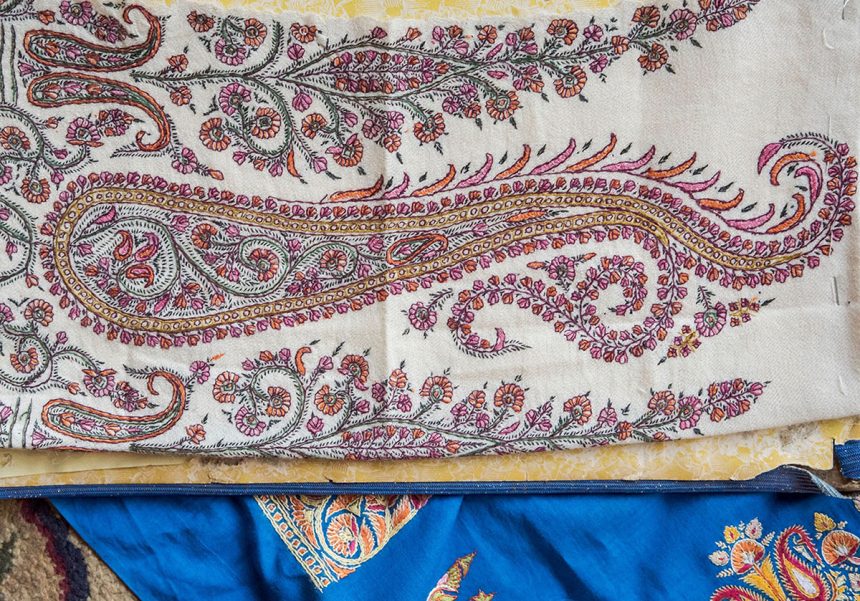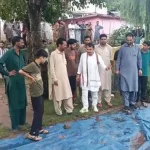PART – II
Cultural Significance of Sozni
Sozni embroidery stands as an exquisite testament to the cultural richness of Kashmir, woven into the very fabric of the region’s identity. Its significance goes beyond being a mere embellishment. It is a cultural phenomenon deeply embedded in the traditions and heritage of Kashmir.
Traditional Attire
One of the most striking aspects of Sozni embroidery is its integral role in traditional Kashmiri attire. The intricate patterns grace the fabric of traditional outfits like Pherans and Shawls, thus turning them into canvases that depict the artistry and cultural depth of the region. Sozni-embroidered garments are not just articles of clothing but symbols of Kashmiri identity, worn with pride and passed down through generations.
Ceremonial Importance
Sozni embroidery plays a crucial role in various ceremonies and celebrations in Kashmir. From weddings to religious festivals, Sozni-embellished garments are often donned as a mark of respect for tradition and a celebration of cultural identity. The meticulous craftsmanship and symbolic motifs contribute to the grandeur of these occasions, creating a visual spectacle that reflects the cultural values of the Kashmiri people.
Symbol of Heritage
In Kashmir, Sozni embroidery is more than a craft; it is a living heritage passed down through centuries. The art form reflects the region’s resilience and cultural continuity despite the passage of time and changing influences. Sozni-embroidered textiles are cherished heirlooms, treasured for their beauty, craftsmanship, and the stories they carry. Families take pride in preserving and passing on these exquisite pieces, contributing to the preservation of Kashmir’s cultural legacy.
Identity and Expression
Sozni embroidery serves as a unique form of self-expression and identity for the people of Kashmir. The motifs, patterns, and colors used in Sozni designs often carry specific meanings and cultural connotations. Wearing Sozni-embroidered clothing becomes a way for individuals to express their connection to Kashmir’s rich cultural tapestry. Further, patrons can showcase their identity in a visually captivating manner.
Economic Empowerment
Beyond its cultural significance, Sozni embroidery also plays a crucial role in the economic landscape of Kashmir. Many artisans and craftsmen rely on Sozni embroidery as a source of livelihood. The craft’s demand in the global market contributes not only to the economic empowerment of individual artisans and communities but also to the promotion of Kashmiri culture on an international stage.
In essence, Sozni embroidery is a living art form that weaves together threads of tradition, identity, and economic sustenance. Its cultural significance is not confined to the past; it continues to evolve and adapt, remaining a vibrant symbol of Kashmiri heritage in the contemporary world.
The Resurgence of Sozni Embroidery
As the world of fashion constantly evolves, traditional art forms find new life through contemporary adaptations. Sozni embroidery, deeply rooted in the cultural tapestry of Kashmir, has experienced a remarkable resurgence in modern fashion. Its intricate patterns and timeless allure have transcended the boundaries of tradition, thus making it a sought-after element on global runways and in collaborations with avant-garde designers.
Runway Renaissance
The intricate beauty of Sozni embroidery has gracefully made its way onto international runways, capturing the attention of designers and fashion enthusiasts alike. Renowned fashion houses have embraced Sozni-embellished ensembles, turning them into statement pieces that redefine the intersection of tradition and modernity. Delicate stitches as well as symbolic motifs have become a canvas for designers to showcase the richness of Kashmiri craftsmanship to a global audience.
Collaborations with Modern Designers
Sozni embroidery’s journey into contemporary fashion is marked by collaborations with modern designers who appreciate its cultural significance. These collaborations serve as a bridge between tradition and innovation, bringing Sozni to new heights of visibility. Designers are incorporating Sozni-embroidered elements into diverse collections, from haute couture to ready-to-wear, hence adding a touch of Kashmiri elegance to the global fashion scene.
Global Fashion Landscape
Sozni embroidery has not only found a place on runways but has also become a sought-after choice for fashion enthusiasts worldwide. Its intricate patterns and cultural depth resonate with those who seek garments that tell a story. Sozni-embellished pieces have become coveted additions to wardrobes. Hence, these symbolize a connection to the rich heritage of Kashmir while making a distinctive fashion statement.
Innovations in Design
Contemporary adaptations of Sozni embroidery often involve innovative design approaches. Designers experiment with new color palettes, unconventional motifs, and unique garment silhouettes to infuse a breath of fresh air into this traditional craft. The adaptability of Sozni embroidery allows it to seamlessly blend with modern aesthetics, thus making it a versatile choice for various fashion expressions.
Cultural Fusion
Sozni’s global journey involves a beautiful fusion of cultures. Designers from different parts of the world are incorporating Sozni embroidery into their creations, thus creating a harmonious blend of traditional Kashmiri artistry and diverse global influences. This cultural fusion not only breathes new life into Sozni but also fosters cross-cultural appreciation and understanding.
Therefore, the contemporary adaptation of Sozni embroidery marks a splendid chapter in the ongoing narrative of Kashmiri craftsmanship. Its presence on runways, collaborations with modern designers, and integration into the global fashion landscape showcase the enduring allure of this traditional art form. Sozni embroidery, far from being confined to the pages of history, continues to evolve and captivate the world with its timeless beauty and cultural depth.
Preservation: Safeguarding the Artistry of Sozni Embroidery
In the face of changing times and evolving fashion landscapes, the need to preserve traditional art forms becomes paramount. Sozni embroidery, deeply embedded in Kashmir’s cultural identity, has garnered attention from preservation initiatives, workshops, and institutions aiming to safeguard this intricate craft.
Artisan Empowerment Workshops
One of the pillars of preserving Sozni embroidery lies in empowering the artisans who carry the legacy of this craft. Artisan empowerment workshops provide a platform for skilled craftsmen to enhance their techniques, learn new skills, and adapt to contemporary demands. These workshops also serve as spaces for knowledge exchange, where older artisans share their expertise with the younger generation, ensuring a seamless transmission of skills.
Institutional Support
Several institutions in Kashmir and beyond are actively involved in preserving and promoting Sozni embroidery. These institutions play a pivotal role in providing financial support, organizing training programs, and creating market linkages for artisans. By recognizing the cultural significance of Sozni, these institutions contribute to the sustainability of this traditional craft.
Government Initiatives
Government initiatives at both regional and national levels have been instrumental in the preservation of Sozni embroidery. These initiatives focus on creating favorable policy environments, offering financial assistance to artisans, and organizing events that showcase Sozni’s cultural richness. By integrating Sozni into broader cultural preservation efforts, governments contribute to ensuring its continued relevance.
Documentation and Archiving
Preserving the heritage of Sozni embroidery involves documenting its history, techniques, and motifs. Archiving this information ensures that future generations have access to a comprehensive record of the craft. Documentation efforts include creating catalogs, recording oral histories of artisans, and establishing digital archives, contributing to the educational aspect of Sozni preservation.
Educational Programs
Educational programs focused on Sozni embroidery play a crucial role in nurturing a new generation of artisans. Workshops, seminars, and skill development programs create a conducive environment for young enthusiasts to explore and engage with Sozni embroidery.
Conclusion: Nurturing Kashmiri Sozni Embroidery
In the tapestry of cultural heritage, Kashmiri Sozni embroidery stands as a delicate thread connecting generations and narrating stories of tradition, skill, and identity. As we’ve delved into the historical roots, techniques, motifs, and contemporary adaptations of Sozni, one can’t help but marvel at the resilience and timelessness of this art form.
The historical journey of Sozni embroidery is nothing short of a captivating narrative, intertwining with the grandeur of Mughal courts and the rich cultural fabric of Kashmir. From its inception, Sozni has been a silent witness to the changing epochs, adapting and flourishing in response to the artistic demands of each era.
The exploration of Sozni’s techniques unveils the meticulous craftsmanship involved in every stitch. The delicate preparation of fine threads and the rhythmic dance of the needle are not merely acts of creation; they are an expression of centuries-old skill passed down through generations. The intricacy woven into each piece is a testament to the artisan’s dedication and the profound connection between hand and craft.
The motifs embroidered onto Sozni’s creations are not merely designs; they are cultural signifiers, each carrying a story, a belief, or a reflection of nature’s beauty. From the chinar leaves to the paisley patterns, every motif contributes to the rich tapestry of Kashmiri artistry, speaking a language that transcends words. Sozni embroidery is not just an embellishment; it’s a cultural emblem deeply rooted in the identity of Kashmir. Its significance in traditional clothing, ceremonies, and daily life solidifies its place as more than a craft—it’s a living heritage that breathes life into every piece it adorns.
(Concluded…)
(Dr. Ankush Mahajan is Poet, Writer, Researcher, and Columnist Pathankot, Punjab. Feedback: [email protected]. And Mrs. Nisha Mahajan is Teaching Assistant (Fashion Technology) Govt. College for Women, Parade Ground, Jammu








